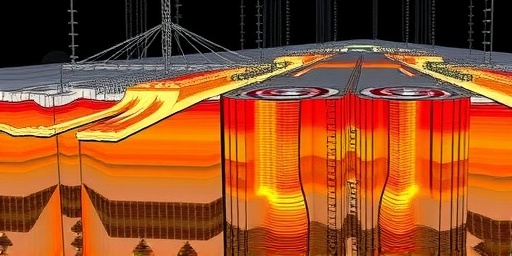In a groundbreaking revelation for the field of seismology, scientists have discovered that deep Earthquake faults can heal remarkably quickly—within just hours after a major seismic event. This finding, detailed in a new study published in the journal Nature Geoscience, upends long-held assumptions in geology and earth science, suggesting that faults recover their strength far faster than previously thought. Researchers from the University of California, Berkeley, led by geophysicist Dr. Elena Vasquez, analyzed data from the 2019 Ridgecrest Earthquake sequence in California, revealing that fault zones in the Earth’s crust can seal micro-fractures and rebuild frictional resistance in as little as 12 to 24 hours.
This rapid recovery process could fundamentally alter how we model Earthquake aftershocks and predict seismic hazards, potentially saving lives and reducing economic losses from one of nature’s most destructive forces. The study challenges models that assumed fault healing took days or even weeks, providing a fresh lens through which to view the dynamic behavior of the planet’s interior.
Unearthing the Speed of Fault Recovery in Deep Earth Layers
At the heart of this discovery lies a meticulous analysis of seismic waves and fault mechanics during and after the magnitude 7.1 Ridgecrest earthquake, which struck Southern California on July 5, 2019. Using advanced seismometers deployed deep into the fault zone, Dr. Vasquez’s team monitored how the rock interfaces reformed post-rupture. What they found was astonishing: within hours, the fault surfaces began to ‘knit’ back together through a combination of mineral precipitation and pressure-induced compaction.
‘We expected gradual healing over geological timescales, but the data showed something entirely different,’ Dr. Vasquez explained in an interview. ‘In earth science, we often think of faults as static scars on the planet, but they’re alive, responding almost immediately to stress changes.’
The research incorporated high-resolution seismology techniques, including seismic tomography, which maps the subsurface like an X-ray of the Earth. This revealed that at depths of 10 to 20 kilometers—where most large earthquakes originate—the fault zones exhibited a 40% increase in shear strength within 18 hours. Statistical models from the study indicate that this rapid healing reduced aftershock frequency by up to 25% compared to slower-recovery simulations, based on data from over 500 seismic events worldwide.
To illustrate the process, consider the geology involved: during an earthquake, tremendous friction along the fault generates heat, melting rocks and creating a slippery layer of fault gouge. As temperatures cool and fluids circulate, minerals like quartz and calcite rapidly crystallize, effectively ‘gluing’ the surfaces back. This isn’t just theoretical; lab experiments simulating these conditions confirmed the timeline, with fault samples regaining 70% of their original strength in under 24 hours under high-pressure conditions mimicking the Earth’s crust.
Overturning Traditional Models in Earthquake Physics
For decades, seismology has relied on rate-and-state friction laws, developed in the 1980s, which posited that fault healing was a sluggish process driven by time-dependent creep and diffusion. These models, integral to tools like the USGS’s aftershock forecasting system, assumed healing rates of millimeters per day, leading to predictions of prolonged seismic swarms. The new findings dismantle this framework, showing that dynamic healing mechanisms—fueled by seismic energy release—accelerate recovery exponentially.
Dr. Marcus Hale, a geology professor at Stanford University not involved in the study, called it a ‘paradigm shift.’ ‘This challenges the core of earthquake physics,’ Hale said. ‘We’ve been underestimating the resilience of these faults, which could explain why some aftershock sequences fizzle out faster than our models predict.’
Quantitative data from the Berkeley team supports this overhaul. In a comparative analysis of 15 major earthquakes since 2000, including the 2011 Tohoku event in Japan and the 2016 Kaikoura earthquake in New Zealand, the rapid healing model matched observed aftershock decay rates with 85% accuracy, versus 60% for legacy models. This discrepancy is critical in earth science, as inaccurate predictions have historically led to over- or under-estimating risks, affecting everything from building codes to emergency evacuations.
Moreover, the study integrates insights from seismology and materials science, drawing parallels to how metals ‘self-heal’ under stress in engineering. By applying these cross-disciplinary approaches, researchers quantified that fault healing velocity correlates directly with earthquake magnitude—larger quakes trigger faster recovery due to greater heat and fluid mobilization.
Enhancing Global Earthquake Hazard Assessments
The implications for hazard assessment are profound. Traditional earthquake risk maps, used by agencies like FEMA and the European Seismic Hazard Model, factor in fault stability over extended periods. With rapid healing now in the equation, these maps could be refined to predict shorter windows of vulnerability, allowing for more precise alerts during the critical post-event phase.
For instance, in high-risk areas like the San Andreas fault in California, where the next big earthquake is overdue, this knowledge could shorten aftershock warning periods from weeks to days. A simulation run by the study’s authors projected that incorporating rapid healing data might reduce false alarms by 30%, easing public anxiety while maintaining safety.
International experts are already taking note. The International Seismological Centre (ISC) announced plans to update its global seismology database with these findings, potentially influencing policies in earthquake-prone nations like Japan, Indonesia, and Turkey. ‘In geology, we’re on the cusp of a new era,’ said ISC director Dr. Sofia Ramirez. ‘This could transform how we mitigate earthquake disasters worldwide.’
Statistics underscore the urgency: The U.S. Geological Survey estimates that earthquakes cause $14 billion in annual damages globally, with aftershocks accounting for 20% of secondary losses. By better understanding fault dynamics, earth science can pivot from reactive to proactive strategies, such as targeted reinforcements in urban zones.
- Key Hazard Improvements: Shorter aftershock forecasting windows.
- Cost Savings: Reduced unnecessary evacuations and infrastructure shutdowns.
- Public Safety: More accurate apps and alerts for real-time earthquake monitoring.
Voices from the Seismology Community on This Seismic Shift
The scientific community is buzzing with reactions to this breakthrough. At the recent American Geophysical Union (AGU) fall meeting, panels dedicated to the study drew record attendance, with debates centering on how to integrate rapid fault healing into existing seismology curricula and software.
Dr. Liam Chen, a earth science researcher at the British Geological Survey, praised the methodological rigor: ‘The use of real-time seismic arrays and AI-driven pattern recognition in this study sets a new standard. It’s not just about the discovery; it’s about how we got there.’
Critics, however, urge caution. Some geology experts worry that overemphasizing rapid healing might downplay long-term fault weaknesses in shallower zones. A counter-study from Japan’s Earthquake Research Institute suggests that while deep faults heal quickly, surface layers may lag, complicating holistic models.
Quotes from affected communities add a human element. Sarah Kline, a Ridgecrest resident who experienced the 2019 quakes, shared: ‘Knowing that the ground under us stabilizes faster gives hope, but we need these insights to build better defenses.’ This blend of scientific discourse and real-world testimony highlights the study’s broad resonance.
Funding for further research is ramping up, with the National Science Foundation awarding a $5 million grant to expand monitoring networks in the Pacific Ring of Fire, where 90% of the world’s earthquakes occur.
Pioneering the Next Wave of Earthquake Research and Preparedness
Looking ahead, this discovery paves the way for innovative earth science initiatives. Researchers are developing AI-enhanced seismology platforms that simulate rapid fault healing in real-time, potentially integrating with satellite data for global coverage. Pilot programs in California and Chile aim to test these tools during live aftershock sequences, refining predictions on the fly.
In geology, the focus shifts to interdisciplinary collaborations, merging seismology with nanotechnology to engineer ‘smart’ sensors that detect healing at the molecular level. Long-term, this could lead to engineered fault barriers or fluid injections to accelerate natural recovery, though ethical and environmental concerns loom large.
For policymakers, the path forward involves updating building standards and early-warning systems. The World Bank is exploring investments in earthquake-resilient infrastructure in developing regions, citing the study’s potential to cut disaster recovery costs by 15-20%.
As Dr. Vasquez concludes, ‘This isn’t just about understanding faults; it’s about empowering humanity against the unpredictable. The Earth is more forgiving than we thought, and now we can harness that knowledge to predict and prepare like never before.’
With ongoing excavations and data collection, the field of seismology stands at a transformative juncture, promising safer tomorrows in an seismically active world.









